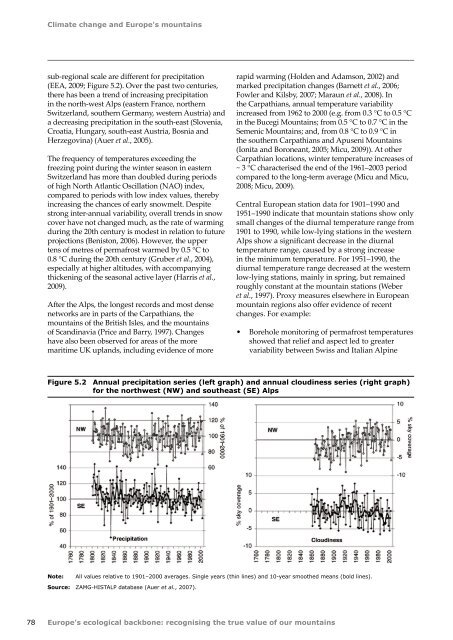Europes ecological backbone.pdf
Europes ecological backbone.pdf
Europes ecological backbone.pdf
Create successful ePaper yourself
Turn your PDF publications into a flip-book with our unique Google optimized e-Paper software.
Climate change and Europe's mountains<br />
sub-regional scale are different for precipitation<br />
(EEA, 2009; Figure 5.2). Over the past two centuries,<br />
there has been a trend of increasing precipitation<br />
in the north-west Alps (eastern France, northern<br />
Switzerland, southern Germany, western Austria) and<br />
a decreasing precipitation in the south-east (Slovenia,<br />
Croatia, Hungary, south-east Austria, Bosnia and<br />
Herzegovina) (Auer et al., 2005).<br />
The frequency of temperatures exceeding the<br />
freezing point during the winter season in eastern<br />
Switzerland has more than doubled during periods<br />
of high North Atlantic Oscillation (NAO) index,<br />
compared to periods with low index values, thereby<br />
increasing the chances of early snowmelt. Despite<br />
strong inter‐annual variability, overall trends in snow<br />
cover have not changed much, as the rate of warming<br />
during the 20th century is modest in relation to future<br />
projections (Beniston, 2006). However, the upper<br />
tens of metres of permafrost warmed by 0.5 °C to<br />
0.8 °C during the 20th century (Gruber et al., 2004),<br />
especially at higher altitudes, with accompanying<br />
thickening of the seasonal active layer (Harris et al.,<br />
2009).<br />
After the Alps, the longest records and most dense<br />
networks are in parts of the Carpathians, the<br />
mountains of the British Isles, and the mountains<br />
of Scandinavia (Price and Barry, 1997). Changes<br />
have also been observed for areas of the more<br />
maritime UK uplands, including evidence of more<br />
rapid warming (Holden and Adamson, 2002) and<br />
marked precipitation changes (Barnett et al., 2006;<br />
Fowler and Kilsby, 2007; Maraun et al., 2008). In<br />
the Carpathians, annual temperature variability<br />
increased from 1962 to 2000 (e.g. from 0.3 °C to 0.5 °C<br />
in the Bucegi Mountains; from 0.5 °C to 0.7 °C in the<br />
Semenic Mountains; and, from 0.8 °C to 0.9 °C in<br />
the southern Carpathians and Apuseni Mountains<br />
(Ionita and Boroneant, 2005; Micu, 2009)). At other<br />
Carpathian locations, winter temperature increases of<br />
~ 3 °C characterised the end of the 1961–2003 period<br />
compared to the long‐term average (Micu and Micu,<br />
2008; Micu, 2009).<br />
Central European station data for 1901–1990 and<br />
1951–1990 indicate that mountain stations show only<br />
small changes of the diurnal temperature range from<br />
1901 to 1990, while low-lying stations in the western<br />
Alps show a significant decrease in the diurnal<br />
temperature range, caused by a strong increase<br />
in the minimum temperature. For 1951–1990, the<br />
diurnal temperature range decreased at the western<br />
low-lying stations, mainly in spring, but remained<br />
roughly constant at the mountain stations (Weber<br />
et al., 1997). Proxy measures elsewhere in European<br />
mountain regions also offer evidence of recent<br />
changes. For example:<br />
• Borehole monitoring of permafrost temperatures<br />
showed that relief and aspect led to greater<br />
variability between Swiss and Italian Alpine<br />
Figure 5.2 Annual precipitation series (left graph) and annual cloudiness series (right graph)<br />
for the northwest (NW) and southeast (SE) Alps<br />
Note:<br />
All values relative to 1901–2000 averages. Single years (thin lines) and 10-year smoothed means (bold lines).<br />
Source: ZAMG-HISTALP database (Auer et al., 2007).<br />
78 Europe's <strong>ecological</strong> <strong>backbone</strong>: recognising the true value of our mountains

















